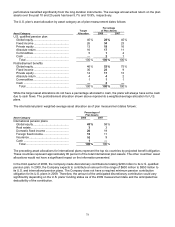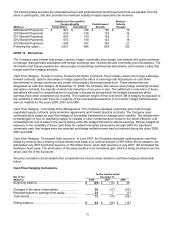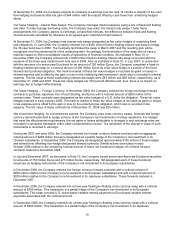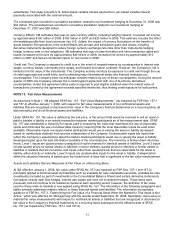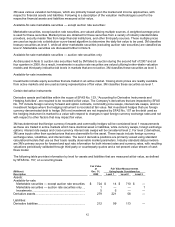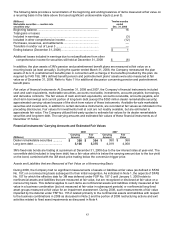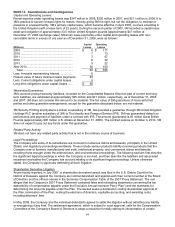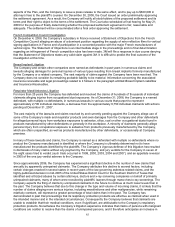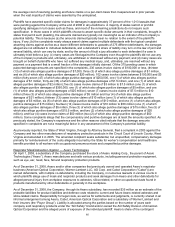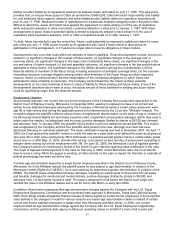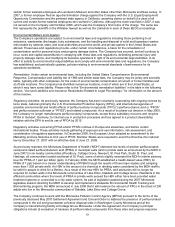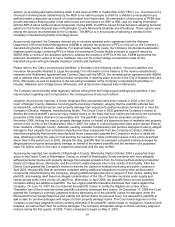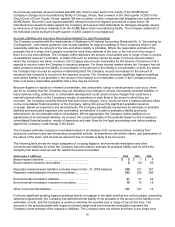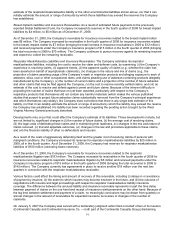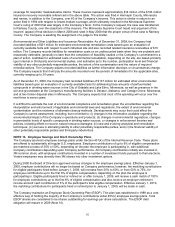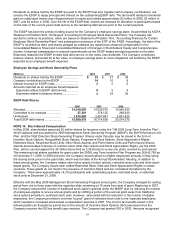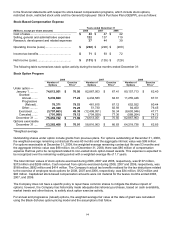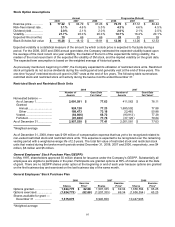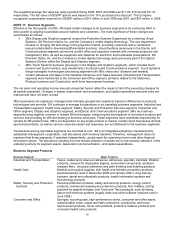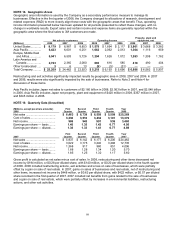3M 2008 Annual Report Download - page 94
Download and view the complete annual report
Please find page 94 of the 2008 3M annual report below. You can navigate through the pages in the report by either clicking on the pages listed below, or by using the keyword search tool below to find specific information within the annual report.
88
certain former salaried employees who worked in Missouri and other states other than Minnesota and New Jersey. In
2007, a former employee filed an age discrimination charge against the Company with the U.S. Equal Employment
Opportunity Commission and the pertinent state agency in California, asserting claims on behalf of a class of all
current and certain former salaried employees who worked in California. Although the claim was filed in 2007, it was
not served on the Company until October 2008, which was the Company’s first notice of the charge. The same law
firm represents the plaintiffs in the Whitaker lawsuit as well as the claimants in each of these EEOC proceedings.
Environmental Matters and Litigation
The Company’s operations are subject to environmental laws and regulations including those pertaining to air
emissions, wastewater discharges, toxic substances, and the handling and disposal of solid and hazardous wastes
enforceable by national, state, and local authorities around the world, and private parties in the United States and
abroad. These laws and regulations provide, under certain circumstances, a basis for the remediation of
contamination and for personal injury and property damage claims. The Company has incurred, and will continue to
incur, costs and capital expenditures in complying with these laws and regulations, defending personal injury and
property damage claims, and modifying its business operations in light of its environmental responsibilities. In its
effort to satisfy its environmental responsibilities and comply with environmental laws and regulations, the Company
has established, and periodically updates, policies relating to environmental standards of performance for its
operations worldwide.
Remediation: Under certain environmental laws, including the United States Comprehensive Environmental
Response, Compensation and Liability Act of 1980 and similar state laws, the Company may be jointly and severally
liable, typically with other companies, for the costs of environmental contamination at current or former facilities and
at off-site locations. The Company has identified numerous locations, most of which are in the United States, at
which it may have some liability. Please refer to the “Environmental remediation liabilities” in the table in the following
section, “Accrued Liabilities and Insurance Receivables Related to Legal Proceedings,” for information on the amount
of the reserve.
Regulatory Activities: As previously reported, the Company has been voluntarily cooperating with ongoing reviews by
local, state, national (primarily the U.S. Environmental Protection Agency (EPA)), and international agencies of
possible environmental and health effects of perfluorooctanyl compounds (“PFCs”) (perflurooctanoic acid or “PFOA”
and perfluorooctane sulfonate or “PFOS”) and related compounds. As a result of its phase-out decision in May 2000,
the Company no longer manufactures perfluorooctanyl compounds, except that a subsidiary recovers and recycles
PFOA in Gendorf, Germany, for internal use in production processes and has agreed to a product stewardship
initiative with the EPA to end its use of PFOA by 2015.
Regulatory activities concerning PFOA and/or PFOS continue in Europe and elsewhere, and before certain
international bodies. These activities include gathering of exposure and use information, risk assessment, and
consideration of regulatory approaches. In December 2006, the European Union adopted an amendment to the
Marketing and Use Directive to limit use of PFOS. Member States were required to enact the Directive into national
law by December 27, 2007 with an effective date of June 27, 2008.
As previously reported, the Minnesota Department of Health (“MDH”) detected low levels of another perfluoronated
compound called perfluorobutanoic acid (PFBA) in municipal wells (and in private wells as announced by the MDH in
June 2007) in six nearby communities (Woodbury, Cottage Grove, Newport, St. Paul Park, South St. Paul, and
Hastings, all communities located southeast of St. Paul), some of which slightly exceeded the MDH’s interim advisory
level for PFBA of 1 part per billion (ppb). In February 2008, the MDH established a health-based value (HBV) for
PFBA of 7 ppb based on a clearer understanding of PFBA through the results of three major studies and sampling
more than 1,000 private wells. An HBV is the amount of a chemical in drinking water considered by the MDH staff to
be safe for people to drink for a lifetime. As a result of this new HBV for PFBA, well advisories will no longer be
required for certain wells in the Minnesota communities of Lake Elmo, Oakdale and Cottage Grove. Residents in the
affected communities where the levels of PFBA in private wells exceed the HBV either have been provided water
treatment systems or connected to a city water system. As part of legislation passed during the 2007 Minnesota
legislative session directing the MDH to develop and implement a statewide Environmental Health Tracking and
Biomonitoring program, the MDH announced in July 2008 that it will measure the amount of PFCs in the blood of 200
adults who live in the Minnesota communities of Oakdale, Lake Elmo and Cottage Grove.
The Company continues to work with the Minnesota Pollution Control Agency (MPCA) pursuant to the terms of the
previously disclosed May 2007 Settlement Agreement and Consent Order to address the presence of perfluoronated
compounds in the soil and groundwater at former disposal sites in Washington County Minnesota and at the
Company’s manufacturing facility at Cottage Grove Minnesota. Under this agreement, the Company’s principal
obligations include (i) evaluation of releases of perfluoronated compounds from these sites and propose response


